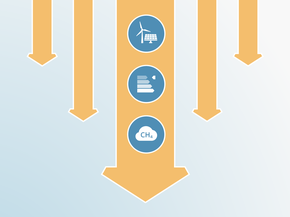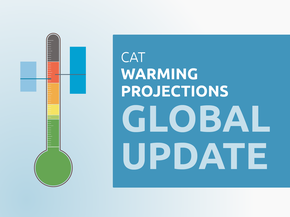Assumptions
Historical emissions
Historical emissions from 1990 to 2021 are taken from PRIMAP (Gütschow and Pflüger, 2023).
NDC
Business-as-usual scenario
Egypt’s updated NDC target is expressed as a reduction below a BAU scenario. Egypt’s NDC only provides BAU values for the electricity, transport and oil & gas sub-sectors. For energy-related CO2 emissions not covered by electricity and transport, we have used a reference scenario from IRENA’s Renewable Energy Outlook report to estimate the BAU values (IRENA, 2018). For other sectors and gases (including the “associated gases” oil & gas sub-sector), we have used a ten-year trend (2006–2015) up to the 2015 baseline year specified in the NDC. As Egypt’s NDC only covers emissions from CO2, CH4 and N20, we have used our current policy projections values for F-gases (instead of estimating a business-as-usual scenario).
Conditional NDC target
We have used the reductions in Egypt’s NDC for the electricity, transport and oil & gas sectors. These reductions represent the upper end of the conditional NDC quantification. For the lower end of the range, we also estimated emissions reductions from the industry and buildings sectors.
Egypt’s NDC refers to the Low-Carbon Roadmap for Egypt’s Cement Sector, which targets a 15% reduction in CO2 emissions from the cement sector (Vanderborght et al., 2016). As cement represents a large share of Egypt’s CO2 emissions in the industry sector, we have assumed this reduction applies to the entire sector and subtracted it from our industry BAU (IRENA’s reference scenario for industry) (IRENA, 2018). For the buildings sector, we have assumed an 8% reduction below IRENA’s reference scenario, in line with the reduction in non-renewable energy use between 2015 and 2030 in IRENA’s enhanced renewable energy (REmap) scenario compared to the reference one in 2030.
Global warming potentials
Egypt’s NDC uses the IPCC’s Second Assessment Report (SAR) Global Warming Potential (GWP) values. The CAT expresses emissions in the IPCC’s Fourth Assessment Report GWPs. For the transport and electricity sectors, we have used the original values from Egypt’s NDC, as most of the emissions in those sectors are from CO2. In 2015, 98% of transport emissions and nearly 100% of emissions from energy industries were from CO2 according to Egypt’s first Biennial Update Report. For the oil & gas sub-sector, we have assumed all emissions are methane, and have converted values from SAR to AR4 GWP.
Current policy projections
We derive the range of projections under current policies according to the following method:
Lower end of the range: Historical data shows that per capita emissions have been largely stable in the past. We assume that this correlation remains and apply the average per capita emissions to UN population prospects until 2030.
Upper end of the range: We use projections from the IRENA RE Outlook for Egypt for energy related CO2 emissions. For all other emissions, we assume a continued trend of past emissions up to 2030.
We further investigate the impact of the RE targets on emissions. Meeting the target does not decrease emissions of the upper end of the range beyond the lower end. Even when assuming a lower electricity generation growth than in the IRENA reference scenario, the emissions reductions compared to the reference do not lead to lower emissions. We thus assume that the target is covered by our range.
Global Warming Potentials values
The CAT uses Global Warming Potential (GWP) values from the IPCC's Fourth Assessment Report (AR4) for all its figures and time series.
Further analysis
Latest publications
Stay informed
Subscribe to our newsletter




